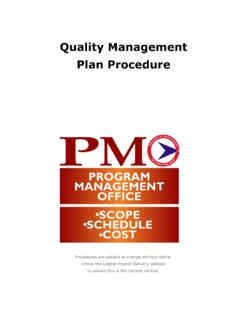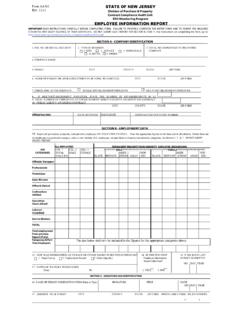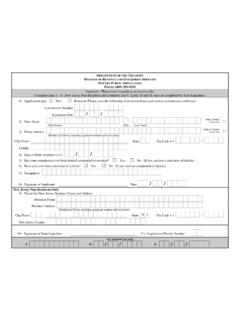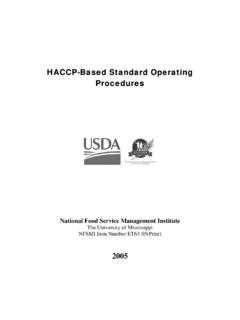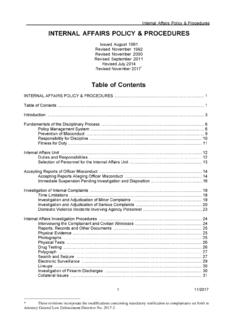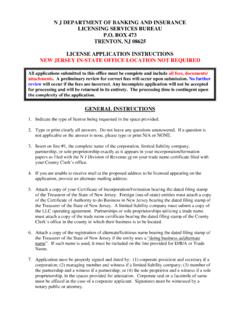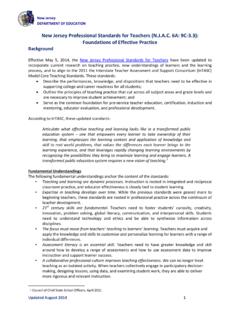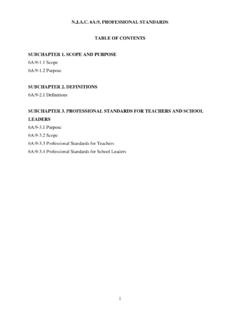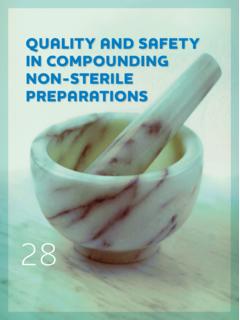Transcription of State of New Jersey
1 DONALD T. DIFRANCESCOA cting GovernorState of New JerseyDEPARTMENT OF LAW AND PUBLIC SAFETYOFFICE OF THE ATTORNEY GENERALPO Box 080 TRENTON, NJ 08625-008(609) 292-4925 JOHN J. FARMER, General1Of 40 cases analyzed, 36 of the subsequent exonerations involved convictions that werebased on one or more erroneous eyewitness identifications. Wells, , , Penrod, Malpass, Fulero, and Brimacombe. Eyewitness Identification Procedures:Recommendations for Lineups and Photospreads. Law and Human Behavior, Vol. 22, No. 18, 2001TO:ALL COUNTY PROSECUTORSCOL. CARSON J. DUNBAR, JR., SUPERINTENDENT, NJSPALL POLICE CHIEFSALL LAW ENFORCEMENT CHIEF EXECUTIVESRe:Attorney general guidelines for Preparing and Conducting Photo and LiveLineup Identification ProceduresIt is axiomatic that eyewitness identification evidence is often crucial in identifyingperpetrators and exonerating the innocent.
2 However, recent cases, in which DNA evidence has beenutilized to exonerate individuals convicted almost exclusively on the basis of eyewitnessidentifications, demonstrate that this evidence is not fool-proof. In one 1998 study of DNAexoneration cases, ninety percent of the cases analyzed involved one or more mistaken The attached Attorney general guidelines for Preparing and Conducting Photoand Live Lineup Identification Procedures, which incorporate more than 20 years of scientificresearch on memory and interview techniques, will improve the eyewitness identification processin New Jersey to ensure that the criminal justice system will fairly and effectively elicit accurate andreliable eyewitness evidence.
3 These guidelines apply to both adult and juvenile cases. With theseGuidelines, New Jersey will become the first State in the Nation to officially adopt therecommendations issued by the United States Department of Justice in its Eyewitness of these guidelines are already being utilized by many of our law enforcementofficers, such as instructing witnesses prior to lineups or photo identifications that a perpetrator maynot be among those in a lineup or photo spread and, therefore, the witness should not feel compelledto make an identification. Two procedural recommendations contained in these guidelines areparticularly significant and will represent the primary area of change for most law enforcementagencies.
4 The first advises agencies to utilize, whenever practical, someone other than the primary2 Cutler, , and Penrod. Mistaken Identification: The Eyewitness, Psychology,and the Law, New York: Cambridge University Press, 1995; Wells, and Bradfield, , Distortions in Eyewitness Recollections: Can the Post-identification Feedback Effect beModerated? , Pyschological Science, , , , Penrod, Malpass, Fulero, and Eyewitness Identification Procedures: Recommendations for Lineups andPhotospreads. Law and Human Behavior, Vol. 22, No. 6. 2investigator assigned to a case to conduct both photo and live lineup identifications. The individualconducting the photo or live lineup identification should not know the identity of the actual provision of the guidelines is not intended to question the expertise, integrity or dedication ofprimary investigators working their cases.
5 Rather, it acknowledges years of research whichconcludes that even when utilizing precautions to avoid any inadvertent body signals or cues towitnesses, these gestures do occur when the identity of the actual suspect is known to the individualconducting the identification procedure. This provision of the guidelines eliminates unintentionalverbal and body cues which may adversely impact a witness ability to make a reliable identification. I recognize that this is a significant change from current practice that will not be possible orpractical in every case. When it is not possible in a given case to conduct a lineup or photo arraywith an independent investigator, the primary investigator must exercise extreme caution to avoidany inadvertent signaling to a witness of a correct response which may provide a witness with afalse sense of confidence if they have made an erroneous identification.
6 Studies have establishedthat the confidence level that witnesses demonstrate regarding their identifications is the primarydeterminant of whether jurors accept identifications as accurate and Technological tools,such as computer programs that can run photo lineups and record witness identifications independentof the presence of an investigator, as well as departmental training of a broader range of agencypersonnel to conduct lineups and photo identifications may also assist agencies and departments withstaff and budget constraints in implementing this recommendation. The guidelines also recommend that, when possible, sequential lineups should be utilizedfor both photo and live lineup identifications.
7 Sequential lineups are conducted by displaying onephoto or one person at a time to the witness. Scientific studies have also proven that witnesses havea tendency to compare one member of a lineup to another, making relative judgements about whichindividual looks most like the perpetrator. This relative judgement process explains why witnessessometimes mistakenly pick someone out of a lineup when the actual perpetrator is not even a witness one photo or one person at a time, rather than simultaneously, permits the witnessto make an identification based on each person s appearance before viewing another photo or lineupmember. Scientific data has illustrated that this method produces a lower rate of If use of this method is not possible in a given case or department, the Guidelinesalso provide recommendations for conducting simultaneous photo and live lineup 3 Although the guidelines are fairly self-explanatory, their implementation will require a steeplearning curve.
8 To that end, training will be conducted. To accommodate appropriate training, theGuidelines will become effective within 180 days of the date of this letter. However, I wouldencourage you to implement the guidelines sooner, if possible. I am requesting that each CountyProsecutor designate key law enforcement personnel and police training coordinators to work withthe Division of Criminal Justice to train your staff as well as the local law enforcement agencieswithin your it is clear that current eyewitness identification procedures fully comport with federaland State constitutional requirements, the adoption of these guidelines will enhance the accuracy andreliability of eyewitness identifications and will strengthen prosecutions in cases that rely heavily,or solely, on eyewitness evidence.
9 The issuance of these guidelines should in no way be used toimply that identifications made without these procedures are inadmissible or otherwise in cooperation is appreciated as all members of our law enforcement community strive toimplement these procedures. Should you have any questions regarding the implementation of theseGuidelines, please contact the Division of Criminal Justice, Prosecutors & Police Bureau, at truly yours,John J. Farmer, GeneralAttachmentcc:Director Kathryn FlickerChief of Staff Debra L. StoneDeputy Director Wayne S. Fisher, Deputy Director Anthony J. Zarrillo, State Investigator John A. CocklinSDAG Charles M. Grinnell, Acting Chief, Prosecutors & Police BureauATTORNEY general guidelines FOR PREPARING AND CONDUCTING PHOTO AND LIVE LINEUP IDENTIFICATION PROCEDURESPREAMBLEW hile it is clear that current eyewitness identification procedures fully comport withfederal and State constitutional requirements, that does not mean that these procedurescannot be improved upon.
10 Both case law and recent studies have called into question theaccuracy of some eyewitness identifications. The Attorney general , recognizing that hisprimary duty is to ensure that justice is done and the criminal justice system is fairlyadministered, is therefore promulgating these guidelines as best practices to ensure thatidentification procedures in this State minimize the chance of misidentification of a THE PHOTO OR LIVE LINEUPThe following procedures will result in the composition of a photo or live lineup inwhich a suspect does not unduly stand out. An identification obtained through a lineupcomposed in this manner should minimize any risk of misidentification and have strongerevidentiary value than one obtained without these procedures.
